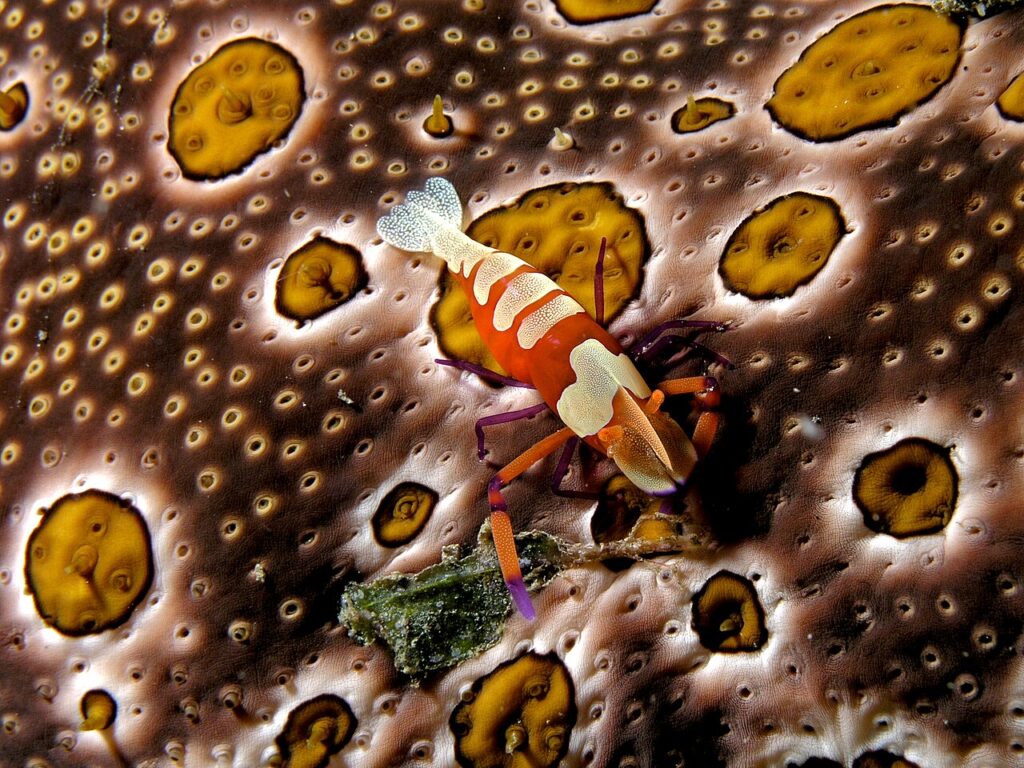Have you ever seen a shrimp hitchhiking on a sea slug’s back? That little traveler is the emperor shrimp, a bright and curious creature that stands out on the reef. With its tiny size and bold colors, it has one of the most unique lifestyles in the ocean.
In this article, we will take a closer look at the emperor shrimp’s life. You will discover what it is, where it lives, how it survives, and more!
What is the Emperor Shrimp?

The emperor shrimp (Zenopontonia rex) is a small but striking crustacean that lives in the warm tropical waters of the Indo-Pacific.
Often measuring less than 2 centimeters, it is famous among divers for its bright orange, white, and purple colors. These vivid markings stand out against the soft bodies of its hosts, making the emperor shrimp one of the most eye-catching animals on the reef.
But why is it called an emperor? The name comes from both its regal colors and its confident presence.
Despite its tiny size, the shrimp sits proudly on the back of its much larger host, almost like royalty being carried on a throne. Watching one perched on a sea slug or sea cucumber, it is easy to see why divers gave this little hitchhiker such a grand title.
Where Do Emperor Shrimp Live?
Emperor shrimp are found throughout the Indo-Pacific, thriving in warm, shallow tropical waters. They are especially common in hotspots like Indonesia, the Philippines, and Papua New Guinea, where sandy slopes and coral rubble provide the perfect setting for their hosts.
If you are wondering where to look for these tiny hitchhikers, here are some of the best dive destinations to encounter emperor shrimp:
- Lembeh Strait, Indonesia: Famous as the muck diving capital of the world, Lembeh is one of the most reliable places to find emperor shrimp riding on sea cucumbers and nudibranchs.
- Anilao, Philippines: A hotspot for macro enthusiasts, Anilao offers excellent opportunities to see emperor shrimp along with countless other small wonders.
- Raja Ampat, Indonesia: Known for its coral reefs and marine diversity, Raja Ampat also hides treasures like the emperor shrimp for divers willing to slow down and look closely.
- Kimbe Bay, Papua New Guinea: This vibrant bay is home to rich reef systems where emperor shrimp can sometimes be found among the many unique macro creatures.
What Does It Eat?

The emperor shrimp feeds on tiny bits of organic matter, algae, and parasites that it finds on its host or in the sand around it.
Using its small claws, it picks up particles directly from the surface of sea slugs or sea cucumbers, almost like a miniature cleaner. This not only gives the shrimp a steady food source but also keeps its host in better condition.
Because of this, the emperor shrimp is more than just a passenger. While it enjoys the safety and free transport that its host provides, it also gives something back by helping to keep the larger animal clean.
You might also like: Harlequin Shrimp: Dive Spots & Photo Tips
How Do Emperor Shrimp Survive?
The life of an emperor shrimp begins in the plankton, where tiny larvae drift with the currents like little specks of life at sea. After several molts, they grow into their adult form and eventually settle on the seafloor.
From there, the search begins for a host such as a sea slug or a sea cucumber. Finding the right ride is a turning point, giving them not only a home but also a way to explore new corners of the reef.
Survival for the emperor shrimp is a mix of clever tricks and lucky partnerships. Their bright colors act as a bold warning to predators, while their small size makes it easy to blend in with larger hosts.
On the reef, they fill an important double role: helping to keep their hosts clean while also becoming a food source for bigger animals.
Want to Meet These Tiny Hitchhikers Yourself?

The emperor shrimp may be tiny, but its bright colors and unusual lifestyle make it one of the most memorable creatures in the ocean. From hitching rides on sea slugs to helping keep reefs healthy, its bold colors and quirky behavior make it a favorite find among divers.
In Lembeh Strait, you have one of the best chances to see emperor shrimp in their natural habitat. At Solitude Lembeh Resort, PADI-certified dive guides make every dive smooth, safe, and rewarding by helping you spot these little hitchhikers along with many other rare critters.
After a day of diving, you can return to the comfort of your private villa and enjoy a warm, home-cooked meal prepared just for you. It is the perfect way to end a day of underwater adventure.
Book your dive adventure with Solitude Lembeh Resort and meet the emperor shrimp in its natural habitat!